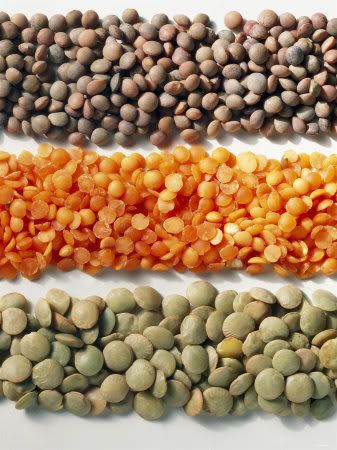|
Each Friday during Lent, the dailySpark will feature a different meat-free main dish. Whether you observe Lent or not, we can all benefit from learning about alternate, affordable proteins. Lentils are a cheap and versatile protein source--I buy lentils for about a dollar a pound in the bulk bins at my local supermarket. On nights when I'm pressed for time, I throw some lentils in a pot, along with a bit of onion and garlic. I add twice as much broth as lentils and let them simmer for about 15 minutes. I steam some broccoli or spinach, heat up some brown rice (I precook rice in batches and freeze it in single portions) and drizzle on a bit of curry or tomato sauce. Dinner's on the table in less than 20 minutes! Most people limit lentils to lentil soup, but these legumes have a lengthy list of uses. A half-cup of lentils have 115 calories, less than half a gram of fat, and 366 mg potassium. They contain 9 g each of protein and fiber (about a third of your recommended amount of fiber), and 45% of your Daily Value of folic acid. Lentils are frequently included on lists of the world's healthiest foods. Find out more about this healthy, cheap and versatile legume! Varieties of lentils:  French lentils (top in photo) are dark green and peppery in flavor. They hold their shape well after cooking but can take longer to cook than brown or orange lentils. These are the lentils to use in salads or dishes where you want the lentils to retain their shape. Red or pink lentils (middle) are a bright shade of salmon when they're dry, but they become mushy and yellow when cooked. They're quite tasty and cook in less than 10 minutes. They are milder and sweeter than other lentils, and because they lose their shape when cooked, they are easier to mix into soups, burgers and stews for added fiber and nutrition. Brown lentils (also called green lentils, German lentils, or Egyptian lentils, bottom) are the most common lentil seen in grocery stores. Khaki in color and mild in flavor, they also hold their shape after cooking--as long as they're not overcooked. Add a bit of oil to the cooking water and cook until just tender, about 15 minutes at a simmer. Black lentils are sometimes called beluga lentils because they shimmer after cooking and look like caviar. How to cook: Lentils need no pre-soaking and cook much more quickly than other dried legumes. Just place them in a strainer (use a mesh strainer rather than your pasta colander so they don't fall through the holes) and give them a rinse. Pick out any debris or shriveled or discolored lentils. Cook lentils with a 2:1 ratio of water or broth and simmer until soft. Depending on the variety, this can take 10 minutes up to an hour. Most varieties will take about 15-20 minutes. Do not add salt to the lentils, as that will cause them to toughen. Add salt to taste after the lentils are cooked. Find plenty of lentil recipes here. Do you eat lentils? How do you prefer to cook them? |
More From SparkPeople
|






.jpg)















